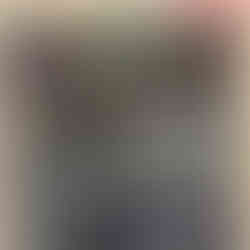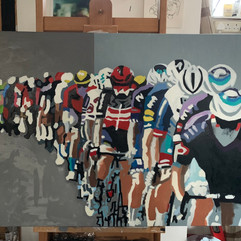Painting development
- Paul Letchworth
- Dec 11, 2023
- 7 min read
Updated: Jan 15, 2024
Overview of the Grand Tours
The subject source for one of my my recent painting series is Mark Cavandish, with my inspiration coming from his performance in the Giro D'italia (pictured above left) Stage 21. In these spectacular events (the grand tours), athletes ride around 2200 miles in 21 days with nearly 60,000 metres of climbing, 22 teams with 8 riders are invited to take part, competing each day for anything up to 6 hours. It is worth noting that during the final stages of the sprint stages Cavandish has been recorded to ride at near to 45mph. For many years I have become immersed in these endurance events, the team tactics and decision making and how the race plays out, the individual battles and the skill and expertise in cycling and the excitement of the racing. The live stream and the playback enable me to slow down and consider the moments, which become the ingredients for my painting.
I have been working on 2 different series of paintings. The Mark Cavandish (Stage 21 Giro D'italia 2023) series and The Peloton series. I have been exploring and experimenting with new ways of using media and my sources.
The Mark Cavandish (Stage 21 Giro D'italia 2023) series
Mark Cavandish has been riding as a professional Grand Tour cyclist, sprint specialist for 15 years and is 38 years old. In this short clip, you will see a slowed down finish line clip within a Eurosport interview. Sat watching this final stage of the Giro live made me want to paint something about this.
During the evolution of these paintings I have returned again and again to different sources - GCN /Eurosport/Giro coverage and Sky recordings that I made of Stage 21. There are at least 3 different angles of the final sprint which have opened up all sorts of possibilities. Using more than a dozen frames taken as screenshots or as photos of the tv screen playing, these images have become the reference ( below image).

De Kooning talks of the "slipping glimpse or the frozen glimpse", as a way to read his abstract work of the 1940's, which i have returned to again and again through my work. De kooning, during this decade, was exploring drawings on transparent tracing paper, scatter them on top of each other and place the work on top of other larger drawings, reworking and rubbing out parts of drawings and reassembling them. Precise and engaging in the art of adjustment was key in his work,with fine lines placed to redefine and re draw the shapes. Paintings such as Night square, Town square, Mailbox(below) have all informed my attempts to explore ways in which to deal with the subject of movement and the abstract qualities of paint and other media. I am intrigued by the ambiguity and the departure from the image through the action of mark making and painting. The departure from the image starts early on, at the print stage. It may be that I adjust the colours or the printer i use is running out of ink. In the drawing stage, I rework and redraw until i arrive at a composition that I am happy with. Colour and brush work continuing, with little reference to the original image. I find that being too literal to the image restricts the freedom found within mark making.
Giro D'italia Cav Acrylic on paper
A2 acrylic painting using the first phone shot from the instagram post, worked from the print out. Once painted (2nd image) I masked off areas and sprayed block sections onto the painting, to break up the image. I took photos of the work and experimented with printing the painting onto textile fabrics (4th Image).
Cav Canvases - I began 3 canvases the same size, square format, and began them in different ways, to explore different approaches:
1. Monochrome Cav Paint & drawing on canvas, which will be layered in white then drawn a new frame over the top and layered in white and so on.
2. Purple ground, directly painting without drawing- after Carters approach working from washed out print out from the frame taken from live video
3. Purple ground and directly painting without the initial drawing
Cav Canvas (3)
Mark Cavandish Giro Ditalia stage 21 (1) Oil on Linen 70 x70cm
The images below show the journey of this painting. Beginning with a ground, then straight into paint ( no drawing out first) I feel that this sometime can restrict the relationship I have with the paint and can become a filling in exercise. Working through the separation of line and background I found that risograph experiments worked successfully and created some really interesting outcomes that familiarised myself with the composition and also the way that I wanted to work in the painting, in particular running the images over and over again through the riso machine, with minor adjustments to each layer has unexpected results. I like to think the digital realm begins to give its voice to the hand made work.
Mark Cavandish Giro Ditalia stage 21 (2) Oil on Linen 70 x70cm Although I began this painting using the frames that showed Cav on the left of the frame, I found that I moved over to placing Cav in the centre rather than on the left. Making for a more balanced composition Scrubbing through the video footage I found a better composition, partly because after playback and rewind I pulled out further elements from the source that I wanted to explore - namely the road markings.
This presenting a perspectival element and also a ghost image of the previous frame, which I left, as I enjoyed what was happening, making a nod to the fast moving frames. Letting the work speak to me, is a key aspect of my creative process.
Mark Cavandish Giro Ditalia stage 21 (1) Pencil, acrylic and oil paint on linen 70 x 70cm : Work in Progress
Looking closely at De Kooning's Town square, which i have lying on my studio floor amongst other De Kooning, images as inspiration. The overlaying and density of De Kooning's composition with layering of pencil and paint marks and very accurate and distilled lines excited me and I began to abstract the shapes more (at present unfinished).
Much of DeKooning's work during the 1940's like Town Square 1948 (oil on paper 17 3/8 × 23 3/4) (below right) were all fairly small, pastel and collaged based paintings, that were made before the larger works that he is most well know for, which he began at the end of the 40's. De Koonings labour intensive working and reworking, reestablishing the marks and the colours (which often had little colour) led into these truly exceptional series of paintings, drawings. Inspired by these I am more interested in the experiment with more abstract concerns - layers, mark making, textures, becoming less specific to the source photographs and videos. The abandoning of colour into monochrome is something I need to explore after looking at De Kooning, Rae, Perfect and their painting.
Cav Graphite and Monoprints and Risographs
The experimentation with Risographs began with the photograph I used for the the large scale drawing on the left and a photograph of the drawing on the left. Working with the images in photoshop I then cleaned up the images ready for the seperation of the line from the shapes. Simplifying the image into 2 allowed for shapes and lines to be layered in a variety of orders. In some I painted and reworked the image. The dotmatrix fround in Richard Prince's show of his photographs fed into the experimentations with riso dot matrix and then onto creating the screen printed dot matrix patterns which I place over the textiles. Monoprints were the next area i wanted to explore, but on reflection i will experiment further with a simpler source image, as I found the image I started with to be too busy.
A2 Acrylic experiments Work in Progress
Ongoing experiments, after further exploration into using the photo/ video in my work, as I worked on these I started to make reference to the devices or screens that I am recording from. Rewinding and replaying the footage, begins to bring in new aspects of the event, such as the road markings, the youtube progress bar and the playback buttons found on the instagram feed. The digital language stepping into the analogue, hand made world of painting, screens in all their forms are integral to our daily lives, with months in a lifetime being lost. Experimentation with spray paints for block areas of colour as this makes for a flat and unsurfaced area, exploration of black and white and mixing greys with primaries and a more gestural abstract approach, larger brushes, pots of mixed paint leading towards starting the larger scale works. Informed by De Kooing and Perfects approach to surface I experimented with working on an uneven surface
Large scale works 105 x 105 cm Oil, oiler, spray paint and chalk on canvas Work in Progress
A key motif of the images that I have been working on has been the road markings and the white, pink and blue lines ( representing the giro colours). Connecting with the work that I have recently been studying by Fiona Rae and Willem de Kooning where they " abandon colour" I am seeking to become more gestural and abstract from the images that I have started with. The largest works in this series, I am working on them side by side using chalk and oil paints, spray paints and keeping the work black and white ( or mixes of these colours).
Peloton Work in progress
The Peloton is a french word that refers to a group of riders in a race. The foreshortening of the shot was what attracted me to the image in the first place, and I wanted to paint it. It began with a charcoal study which was made with the earlier works of the Cavandish series. Reworking and redrawing until I arrived at the composition which worked. This then became a base for the risographs. The lower photos are the evolution of the oil painting.
Studio 49 : Studio shots of my studio space at home :
Oil painting Zone / Acrylic zone / Digital zone / Spraypaint area / Storage






































































































































Comments